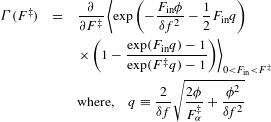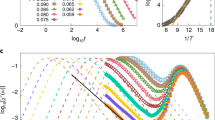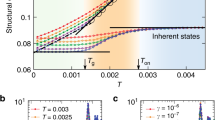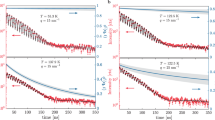Abstract
Supercooled liquids and glasses show a range of relaxation times. Nearly all glass-forming liquids show secondary relaxations, high-frequency dynamical modes of structural reconfiguration seemingly distinct from the primary alpha relaxations. We show that accounting for driving-force fluctuations and the diversity of reconfiguring shapes in the random first-order transition theory yields a new dynamical process that shares many of the features ascribed to secondary relaxations. Whereas primary relaxation takes place through activated events involving compact regions, secondary relaxation is governed by more ramified, string-like or percolation-like clusters of particles. These secondary relaxations generate a low free-energy tail on the distribution of activation barriers, which becomes more prominent with increasing temperature. The activation barrier distributions of the two processes merge near the dynamical-crossover temperature Tc, where the secondary process ultimately becomes the dominant mode of structural relaxation. These string-like reconfigurations are seen to smooth the transition at Tc between high-temperature collisional dynamics and activated events.
This is a preview of subscription content, access via your institution
Access options
Subscribe to this journal
Receive 12 print issues and online access
$209.00 per year
only $17.42 per issue
Buy this article
- Purchase on Springer Link
- Instant access to full article PDF
Prices may be subject to local taxes which are calculated during checkout






Similar content being viewed by others
Change history
18 February 2015
In the version of this Article originally published the equation for the distribution of free energy barriers, which follows equation 4, was incorrect and should have read:

. This error has now been corrected in the online versions of the Article.
References
Adichtchev, S. et al. Fast relaxation processes in glasses as revealed by depolarized light scattering. J. Non-Cryst. Solids 353, 1491–1500 (2007).
Kudlik, A., Benkhof, S., Blochowicz, T., Tschirwitz, C. & Rossler, E. The dielectric response of simple organic glass formers. J. Mol. Struct. 479, 201–218 (1999).
Ngai, K. L. & Capaccioli, S. Relation between the activation energy of the Johari–Goldstein β relaxation and Tg of glass formers. Phys. Rev. E 69, 031501 (2004).
Wang, L. M. & Richert, R. Primary and secondary relaxation time dispersions in fragile supercooled liquids. Phys. Rev. B 76, 064201 (2007).
Lunkenheimer, P., Schneider, U., Brand, R. & Loidl, A. Glassy dynamics. Contemp. Phys. 41, 15–36 (2000).
Frauenfelder, H. et al. A unified model of protein dynamics. Proc. Natl Acad. Sci. USA 106, 5129–5134 (2009).
Thayyil, M. S., Capaccioli, S., Prevosto, D. & Ngai, K. L. Is the Johari–Goldstein beta-relaxation universal? Phil. Mag. 88, 4007–4013 (2008).
Lubchenko, V. & Wolynes, P. G. Theory of structural glasses and supercooled liquids. Ann. Rev. Phys. Chem. 58, 235–266 (2007).
Xia, X. & Wolynes, P. G. Fragilities of liquids predicted from the random first order transition theory of glasses. Proc. Natl Acad. Sci. USA 97, 2990–2994 (2000).
Stevenson, J. D. & Wolynes, P. G. Thermodynamic–kinetic correlations in supercooled liquids: A critical survey of experimental data and predictions of the random first-order transition theory of glasses. J. Phys. Chem. B 109, 15093–15097 (2005).
Lubchenko, V. & Wolynes, P. G. Theory of ageing in structural glasses. J. Chem. Phys. 121, 2852–2865 (2004).
Xia, X. & Wolynes, P. G. Microscopic theory of heterogeneity and nonexponential relaxations in supercooled liquids. Phys. Rev. Lett. 86, 5526–5529 (2001).
Dzero, M., Schmalian, J. & Wolynes, P. G. Replica theory for fluctuations of the activation barriers in glassy systems. Phys. Rev. B 80, 024204 (2009).
Stevenson, J. D., Schmalian, J. & Wolynes, P. G. The shapes of cooperatively rearranging regions in glass-forming liquids. Nature Phys. 2, 268–274 (2006).
Kirkpatrick, T. R., Thirumalai, D. & Wolynes, P. G. Scaling concepts for the dynamics of viscous liquids near an ideal glassy state. Phys. Rev. A 40, 1045–1054 (1989).
Biroli, G., Bouchaud, J.-P., Cavagna, A., Grigera, T. S. & Verrocchio, P. Thermodynamic signature of growing amorphous order in glass-forming liquids. Nature Phys. 4, 771–775 (2008).
Cammarota, C., Cavagna, A., Gradenigo, G., Grigera, T. S. & Verrocchio, P. Surface tension fluctuations and a new spinodal point in glass-forming liquids. Preprint at <http://arxiv.org/abs/0904.1522> (2009).
Capaccioli, S., Ruocco, G. & Zamponi, F. Dynamically correlated regions and configurational entropy in supercooled liquids. J. Phys. Chem. B 112, 10652–10658 (2008).
Stevenson, J. D., Walczak, A. M., Hall, R. W. & Wolynes, P. G. Constructing explicit magnetic analogies for the dynamics of glass forming liquids. J. Chem. Phys. 129, 194505 (2008).
Adam, G. & Gibbs, J. H. On the temperature dependence of cooperative relaxation properties in glass-forming liquids. J. Chem. Phys. 43, 139–146 (1965).
Bhattacharyya, S. M., Bagchi, B. & Wolynes, P. G. Facilitation, complexity growth, mode coupling, and activated dynamics in supercooled liquids. Proc. Natl Acad. Sci. USA 105, 16077–16082 (2008).
Flory, P. J. Principles of Polymer Chemistry (Cornell Univ. Press, 1953).
Hagedorn, R. Statistical thermodynamics of strong interactions at high-energies. Nuovo Cimento. Suppl. 3, 147 (1965).
Plotkin, S. S. & Wolynes, P. G. Buffed energy landscapes: Another solution to the kinetic paradoxes of protein folding. Proc. Natl Acad. Sci. USA 100, 4417–4422 (2003).
Redner, S. A Guide to First-Passage Processes (Cambridge Univ. Press, 2001).
Wiedersich, J. et al. Fast and slow relaxation processes in glasses. J. Phys. Condens. Matter 11, A147–A156 (1999).
Leutheusser, E. Dynamical model of the liquid–glass transition. Phys. Rev. A 29, 2765–2773 (1984).
Gotze, W. & Sjogren, L. Relaxation processes in supercooled liquids. Rep. Prog. Phys. 55, 241–376 (1992).
Singh, Y., Stoessel, J. P. & Wolynes, P. G. Hard-sphere glass and the density-functional theory of aperiodic crystals. Phys. Rev. Lett. 54, 1059–1062 (1985).
Franz, S. Metastable states, relaxation times and free-energy barriers in finite-dimensional glassy systems. Europhys. Lett. 73, 492–498 (2006).
Mezard, M. & Parisi, G. Statistical physics of structural glasses. J. Phys. Condens. Matter 12, 6655–6673 (2000).
Blochowicz, T., Tschirwitz, C., Benkhof, S. & Rossler, E. A. Susceptibility functions for slow relaxation processes in supercooled liquids and the search for universal relaxation patterns. J. Chem. Phys. 118, 7544–7555 (2003).
Blochowicz, T., Gainaru, C., Medick, P., Tschirwitz, C. & Rossler, E. A. The dynamic susceptibility in glass forming molecular liquids: The search for universal relaxation patterns II. J. Chem. Phys. 124, 134503 (2006).
Döß, A., Hinze, G., Schiener, B., Hemberger, J. & Böhmer, R. Dielectric relaxation in the fragile viscous liquid state of toluene. J. Chem. Phys. 107, 1740–1743 (1997).
Acknowledgements
Support from NSF grant CHE0317017 and NIH grant 5R01GM44557 is gratefully acknowledged. Discussions on this topic with V. Lubchenko, H. Frauenfelder and J. Schmalian are gratefully acknowledged.
Author information
Authors and Affiliations
Contributions
The authors together conceived and implemented the theory and wrote the paper. J.D.S. implemented the numerical work.
Corresponding author
Rights and permissions
About this article
Cite this article
Stevenson, J., Wolynes, P. A universal origin for secondary relaxations in supercooled liquids and structural glasses. Nature Phys 6, 62–68 (2010). https://doi.org/10.1038/nphys1432
Received:
Accepted:
Published:
Issue Date:
DOI: https://doi.org/10.1038/nphys1432
This article is cited by
-
Medium-range imperfect order determining the slow β-relaxation in metallic glasses
Science China Materials (2024)
-
Microscopic origin of excess wings in relaxation spectra of supercooled liquids
Nature Physics (2022)
-
Merging of relaxations and step-like increase of accompanying supercooled liquid region in metallic glasses via ultrafast nanocalorimetry
NPG Asia Materials (2022)
-
Experimental evidence of mosaic structure in strongly supercooled molecular liquids
Nature Communications (2021)
-
Distinctive Slow β Relaxation and Its Impact on Mechanical Property of LaCe Based Bulk Metallic Glasses
Metals and Materials International (2020)




